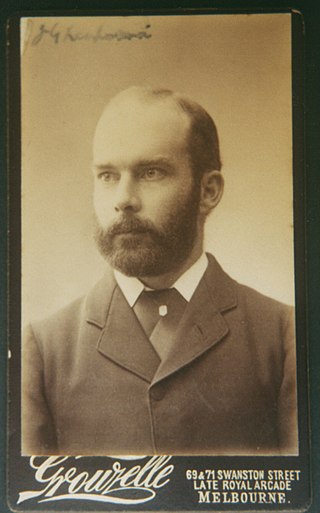
Baron Sir Ferdinand Jacob Heinrich von Mueller, was a German-Australian physician, geographer, and most notably, a botanist. He was appointed government botanist for the then colony of Victora, Australia by Governor Charles La Trobe in 1853, and later director of the Royal Botanic Gardens in Melbourne. He also founded the National Herbarium of Victoria. He named many Australian plants.

The Royal Society of Victoria (RSV) is the oldest scientific society in Victoria, Australia.

Archibald James Campbell was an Australian civil servant in the Victorian government Customs Service. However, his international reputation rests on his expertise as an amateur ornithologist, naturalist, and photographer.
The Western Australian Herbarium is the State Herbarium in Perth, Western Australia.
Margaret Alison Cameron AM, FRAOU was a noted Australian librarian, administrator, and amateur ornithologist. She was the foundation librarian of Deakin University between 1977 and 1996, and pro vice-chancellor of the University from 1986 to 1990. She joined the Royal Australasian Ornithologists Union (RAOU) in 1969 which she served as President from 1986 to 1989.
The Australian Natural History Medallion is awarded each year by the Field Naturalists Club of Victoria (FNCV) to the person judged to have made the most meritorious contribution to the understanding of Australian Natural History. The idea originated with J. K. Moir, a book collector and member of the Bread and Cheese Club. Moir wrote to the FNCV in 1939 suggesting that such a medallion should be awarded to a person who had performed, in his words, ‘a signal service’ to the protection of flora and fauna—‘a variation of the Nobel awards’. Nominations for the Medallion are made by field naturalist clubs and kindred bodies from all over Australia, each nomination being valid for a three-year period. The Medallion has usually been awarded annually since 1940. In that time, recipients have been honoured for their work in many fields of natural history studies, and have come from every state and territory in Australia.
Bruce Alexander Fuhrer OAM was an Australian botanist and photographer, specialising in cryptogams. His photographic collection of fungi numbers more than 3000 species.

Charles French was an Australian horticulturist, naturalist, entomologist and plant/seed collector who made significant contributions to economic entomology. French was the first economic entomologist in Australia and served as Government Entomologist in Victoria from 1889.

The Victorian Naturalist is a bimonthly scientific journal covering natural history, especially of Australia. It is published by the Field Naturalists Club of Victoria and is received as part of the membership subscription of that club. From 1881, club proceedings and papers had been published in the Southern Science Record and Magazine of Natural History before the first issue of The Victorian Naturalist appeared in January 1884. The journal publishes peer-reviewed research articles, research reports, "Naturalist Notes", and book reviews. The journal was published monthly until 1976, since then it has been published bimonthly. In that period several special issues have been published. These covered particular natural history topics or significant centenaries: of the club (1980), the death of Ferdinand von Mueller (1996), and the establishment of Wilsons Promontory National Park and Mount Buffalo National Park (1998). In 2001 there was a special issue on Frederick McCoy, the first president of the club. The journal was abstracted and indexed by Scopus in 1980 and 1984 and from 2008 to 2014.

The Geelong Field Naturalists Club (GFNC) is an Australian regional amateur scientific natural history and conservation society which was originally founded in the 1890s and re-established in 1961 in its present form. It is based in Geelong, Victoria, with the aims of preserving and protecting native flora and fauna, promoting the conservation of natural resources and the protection of endangered species and habitats, and recording information and knowledge about the flora and fauna of the Geelong region.
Norman Arthur Wakefield was an Australian teacher, naturalist, paleontologist and botanist, notable as an expert on ferns. He described many new species of plants.

Johann George Luehmann was an Australian botanist, who served as the Assistant Botanist and, later, as the Curator at the National Herbarium of Victoria, and who also, from 1896, served as the Government Botanist of Victoria.
Kate Julia Cowle was the first recorded Australian female to trek to the top of Cradle Mountain, Tasmania, in 1910. A pioneering naturalist and conservationist, she summited the mountain along with her fellow climbers Gustav Weindorfer, Ron Smith and Walter Malcolm Black.
Fanny Anne Charsley was a botanical artist and collector. She collected plants for the Victorian government botanist, Baron Ferdinand von Mueller who named the Australian flower Helipterum charsleyae in her honour. The flower has since been reclassified as Rhodanthe charsleyae and is a species of paper daisy. Her publication Wild Flowers Around Melbourne was one of the first books on Victorian flora aimed at the general public.
Margaret Georgina Corrick was an Australian botanist. She collected over 10,000 specimens and was an expert on Pultenaea.
The Castlemaine Field Naturalists Club (CFNC) is an Australian regional natural history society dedicated to the study, appreciation and conservation of the natural environment in the Castlemaine region of Victoria. Founded in 1976, the CFNC has played a pivotal role in promoting environmental awareness and scientific enquiry within the Castlemaine community.
The Latrobe Valley Field Naturalists Club is an Australian regional scientific natural history and conservation society. It is based in the Latrobe Valley in Victoria and draws members from across western, central and southern Gippsland.
The Field Naturalists' Club of Ballarat (FNCB) is an Australian regional scientific natural history and conservation society. The club was founded in 1952 (a continuation of the Field Club and Science Society) and is located in Ballarat, Victoria.
The Bendigo Field Naturalists Club (BFNC) is an Australian regional scientific natural history society, dedicated to the study, appreciation and conservation of the natural environment. It is located in Bendigo, in central Victoria and focuses on the native biodiversity of the Bendigo Valley.








